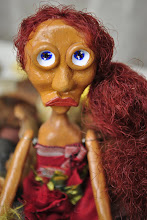Gallery Exhibit
On Wednesday February 23rd, our class went on three photo gallery exhibits. These three exhibits had very different themes to them. There was one that had different bedroom furniture from possibly different countries and time periods. They made you want to know more about the person that slept in them as well as more about the way the rest of the house may have looked. This exhibit also had photos from modern day homes that used warm colors that seemed to have given life and a homey feeling to them. The third part of that exhibit looked like it was done in some kind of abandoned building and left the viewer with a cold feeling of loneliness especially in the photo where the paint was peeling off of the ceiling and a single chair was left in the middle of the room. The second exhibit was at the Luhring Augustine gallery and the theme of that exhibit seemed to be the artist transforming famous paintings and etchings by Goya into a work of his own. The third exhibit which was at the Yancy Richardson gallery had more of a theme of taking reality and making it into a painting by using bright colors with high contrast. Some of the photos would have to be seen from a close range so that you could see that they are not paintings. Out of these three exhibits. I chose to write on Morimura. I found his work to be the most striking out of them all.
I found Morimura’s photos to be very interesting because they used the colors to tell the story. In the photo named “fated to wait for someone’s death”, everything from the background of the photo to the clothing of the subjects were dull colors. The dull colors immediately make the viewer aware that the mood of this photo is not a happy one. The colors prepare you for the morbid nature of the photo in which the woman is holding the heart of a dead man. I feel that the use of color helps to convey the overall main idea of the photo.
The thing had initially attracted me to his work was that they were recognizable masterpieces that were remade with a totally different approach Not only does Morimura redo other peoples work, he poses in the photos as the leading subject. I think it is very creative of him to take somebody’s work and transform it by using different media and elements. If you were to put one of his photos next to one of Goya’s originals you would see that they share the same subject manner and composition but you would realize that they feel different. With Goya’s pieces you get a feeling of roughness and more of a harsh feeling with them I guess because of the fact of them being etchings. In Morimura’s photos, you get a feeling of quirkiness because of Morimura posing as the subject whether they are male or female. The titles of these etchings as well as the photos are quirky as well. The title becomes like that funny joke that that makes you laugh at it hours after you hear it making you think of the photo that it belongs to more often then others. I feel that Morimura’s work is creative in a sense that he creates elaborate creatures for some of his photos. This is what makes him a haptic photographer to me. He doesn’t just go out and take a picture of his surroundings, he creates and gives emotions to them. The facial expressions on these creatures are so realistic that they seem to be alive. This mixture of different elements are what I believe makes his images arrestingly beautiful. I hope that some day I will be able to create images as crisp and sophisticated as Morimura. His photos are so strong that they don’t need to be seen in a series. They are able to stand alone because each one of them tells a different story. You are able to understand by the picture by itself as well as the text that goes along with it.


2 Comments:
Great description of all three exhibits. Given your own interest in photographing mannequins, I can understand your attraction to Morimura's work. I agree with your assessment that Morimura is lighter in tone than Goya. Goya was concerned with the utter corruption of the ruling class of his time and the horrors of war. What are Morimura's subjects? How much of a factor is it that he is the central model in every photograph? Also, this work is of a strikingly larger size than any of the other work we saw on our gallery tour. How does that add to the viewer's experience?
thank you for the comment. I knew that Goya's tone wasn't as light as Morimura's but I didn't know that he was trying to demonstrate how corrupted the upper class was. I wasn't really clear on that. Morimura's subjects are basically himself and things that are created by him. He doesn't photograph reality. He only takes photos of his own creations or re-creations. It is a big factor that he is the central figure in most of his photos because he is the character that is telling the story. Without him there wouldn't be a story. The size of his work is just about life size in comparison to the other works in the gallery tour. You become more invloved in his photos and almost feel as if you could step right into them.
Post a Comment
<< Home